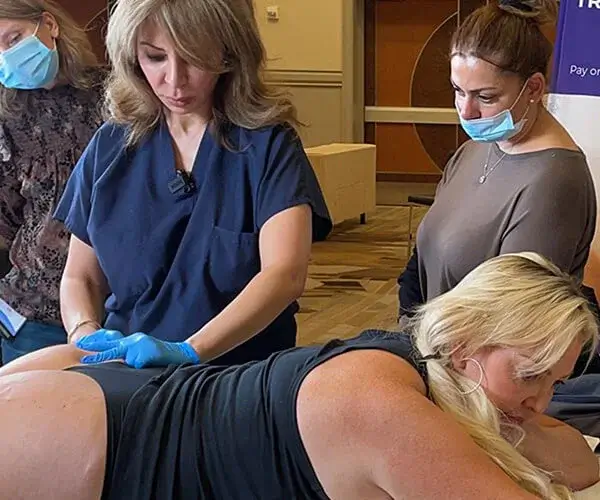Guide to Spinal Manipulation Courses
By Dr. Stephen Cosentino
PRESIDENT OF EMPIRE MEDICAL TRAINING
About 8% of American adults experience chronic back pain severe enough to limit function, according to the Georgetown Health Policy Institute. Vastly more experience back pain regularly, missing nearly 100 million days of work each year as a result.
Low back pain is no joke. But recent advancements in spinal manipulation therapy promise relief for sufferers — and opportunity for pain management practitioners. In fact, Multiple high-quality studies have found spinal manipulation to be effective for the treatment of chronic low back pain.
Whether you’re a chiropractic neurologist, a licensed massage therapist, or physical therapist interested in adding spinal manipulation to your menu of services, an accredited spinal manipulation therapy course can set you up for success. Find out what to expect from one of these spinal manipulation workshops and how to choose the best one.
What Are Spinal Manipulation Courses?
Spinal manipulation training courses teach evidence-based physical therapy techniques for the cervical spine. These courses generally focus on high velocity low amplitude (HVLA) thrust techniques, which may reduce back pain in patients whose conditions don’t respond well to conventional treatments.
Some spinal manipulation classes are comprehensive, covering the full range of current best practices across all areas of the neck and back (the cervical, thoracic, and lumbar vertebrae). Others focus on specific manipulation techniques and related treatments, such as dry needling, or on particular areas of the neck and back. They’re often intended to be taken sequentially, with official certification in spinal manipulative therapy coming after the entire series is completed.
The best spinal manipulation training sessions are accredited and offer legitimate certification upon successful completion. They’re supervised by board-certified osteopaths or chiropractors with years of clinical practice experience. They include classroom-based teaching, hands-on demonstrations, and comprehensive course resources for trainees to review at their convenience. They complement related pain management coursework in practice areas like nonspinal joint injections and botulinum toxin treatment for chronic migraine.
What to Expect From a Spinal Manipulation Course
Comprehensive spinal manipulation courses typically last two days, with a mix of prerequisite material (delivered online before the course begins) and in-person didactic and hands-on instruction.
Complaints and Conditions
Each spinal manipulation training program is different, but you can expect yours to cover the following subjective complaints:
- Back and neck muscle spasms
- Sacroiliac dysfunction
- Range of motion loss in the upper body
- Lumbar pain
- Sacrum pain
And screening/diagnosis procedures to exclude and diagnose a range of conditions that contribute to back and neck pain:
- Functional testing, including seated straight raise, supine SLR, and Kemp’s extension test
- X-rays and MRI disc pathology scans
- SI joint testing, including the Fortin finger test, FABER, and SI compression
- Muscle testing, including Hallux and eversion/inversion testing
Techniques and Areas of the Body
Comprehensive spinal manipulation courses focus on HVLA thrust manipulation techniques up and down the back and neck. Focus areas for specific manual therapy techniques may include:
- The L2-L5 series, a common focal point for low back pain
- The thoracolumbar junction (T10-L1)
- The sacroiliac area
- The C6-C8 series, a common focal point for nerve-related hand and arm pain
- The C3-C5 series, associated with phrenic nerve pain and dysfunction
Course Objectives
Your spinal manipulation training should prepare you to:
- Make informed clinical decisions around spinal therapies, including identifying patients likely to benefit from treatment and assessing potential contraindications
- Accurately and efficiently diagnose various conditions that may benefit from spinal manipulation therapies
- Apply best-practice spinal manipulation techniques across a range of conditions and areas of the back and neck
- Assess each patient’s unique anatomy to devise a treatment plan
- Properly position patients for maximum leverage and impact during treatment
Expanding Your Pain Management Toolkit with Spinal Manipulation
Spinal manipulation therapy represents an important tool in the arsenal of healthcare providers who treat back and neck pain. By completing an accredited spinal manipulation course, practitioners can expand their clinical capabilities and offer patients a wider range of evidence-based treatment options.
These comprehensive training programs provide the knowledge and hands-on skills needed to safely and effectively apply HVLA thrust techniques, mobilization methods, and complementary modalities like dry needling. Participants learn to identify the patients most likely to benefit, perform thorough assessments, and develop personalized treatment plans.
As the burden of chronic musculoskeletal pain continues to grow, the demand for skilled spinal manipulation providers will only increase. Completing a high-quality certification course can position you to meet this need, enhance your clinical outcomes, and better serve your patients struggling with debilitating back and neck conditions. With the right training and expertise, spinal manipulation can become a powerful addition to your pain management toolkit.


